 Photo From pixabay
Photo From pixabayOriginally Posted On: https://gogetgame.com/article/how-to-play-sudoku/
A complete guide to Sudoku for beginners and experts
Sudoku is an entertaining board game that is based on logic. The combinatorial puzzle requires players to place numbers across the board logically. And on a classic Sudoku board, there is a 9×9 grid featuring digits in columns and rows. So, how to play sudoku games?
From the Sudoku grid, players’ primary objective is to complete the grids across each of the 3×3 sub-grids, each row, and column with digits from 1 to 9.
Yes! It’s as simple as it sounds but doesn’t get it twisted. It can make you sweat a bit.
So are you new to the Sudoku board game? Or have you always tried to understand the puzzle game with no success?
Don’t fret anymore if you are yet to understand the logic-based game. Though it’s always that challenging and puzzling for beginners, it will be demystifying everything about the game for you in the simplest possible form.
Some of the essential things you should expect to learn from this guide include but not limited to:
- What is Sudoku?
- Understanding Sudoku instruction
- Variants of Sudoku puzzle
- How to play Sudoku from beginners to experts
- Learning Sudoku rules for a better understanding of the board game
- Different strategies for solving puzzle games with ease.
Sudoku comes in different layouts and levels, but once players understand the board game’s basics, they can easily break the most challenging puzzles and equally face the best of the bests.
Join the ride as we solve the mysteries of the Sudoku board game.
What is Sudoku?There are several board and puzzle games. And Sudoku belongs to this game category alongside several others such as Chess, Tetris, and Monopoly. Typically, Sudoku is a logic-based, number-placement puzzle primarily designed for a single player.
The game design makes it similar to a crossword puzzle, but this deals majorly with numbers except in some Japan variants Sudoku. The board layouts comprise a grid of small boxes of cells that are stacked 3×3 high and wide. The grids of 9 make up 81 cells in total.
Some of the cells on the Sudoku board are always occupied with numbers while some are left empty as displayed in the image below:
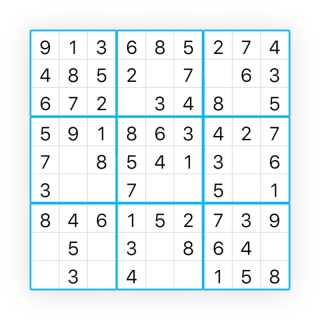
A typical image showing the Sudoku puzzle layout from Sudoku Online Game
Learning the main play Sudoku rules and objectivesDifferent games and their varying objectives. But the Sudoku puzzle seems to have the most simple and straightforward goal. Yes! Because it only requires you to fill in the empty cells.
Don’t get it twisted. It’s effortless but dicey. You are only allowed to fill in space in a particular order, or if done otherwise, you are bound to lose out on the game.
As you fulfill the objective of the game, here are the binding Sudoku rules of thumb you have to also put in mind:
- Fill in the empty cells in the column, row, and block
- No repeats are allowed in any row, column, or block
- Use all nine numbers in each row, column, and block.
Check the image below for a pictorial understanding of the main objective:
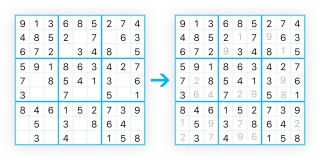
Image showing the pictorial objective of Sudoku
Let’s get into more details on the Sudoku rules and objectives of Sudoku:
As you observe in the image above, filling in the empty spaces on the game board seems simple and straightforward. But never forgets, it is logic-based, and it can make you sweat out.
The truth is, you have to fill in the spaces carefully, noting that there is only one correct answer for each empty cell since you can only use a number once across a row, column, or block.
You can see now that the objective is getting more severe than just filling in the empty cells. It’s more of figuring out the number that goes in and where exactly it goes to on the board.
When starting the Sudoku puzzle, always remind yourself that the pre-filled cells are not randomly filled but rather deliberately positioned to make you provide just a single but final solution to the puzzle.
To reiterate the Sudoku instruction, you need to follow once again in a clear and simple sentence:
«The objective is to solve the puzzle across the cells
until all empty cells are correctly filled in»
Oh. I suck at Math: Can I still solve and play Sudoku?Many people claim their weakness in math has been the reason why they don’t play Sudoku. But would you like to hear the truth, Sudoku requires no math to unravel it.
Though the puzzle game is logic-based and deals with number placement, you still require no calculations to be the best at the board.
Shockingly, not all Sudoku variants involve numbers. Some use nine letters of the alphabets, pictures, colors, or even Japanese symbols as replacements for numbers. Therefore, number usage in Sudoku is only widespread and well-adopted because they are generally recognized symbols.
Now that you are convinced that math is no requirement for Sudoku don’t try to rule out the place of logic and rational thinking and placement of numbers as you play Sudoku.
Learning Other Sudoku VariantsSudoku remains one of the famous puzzle games with numerous variants. And over the years, several variants have cropped up with different background histories and interests. A fascinating variant aside from the original 9×9 one is the Sudoku for kids.
Check below for the list of some Sudoku variants you can get familiar with:
- Original 9×9 Sudoku Variant
As described explicitly before, this is the original layout and design for Sudoku with a 9×9 grid that runs into different columns, rows, and blocks. It is the most popular and well-known of all the Sudoku variants.
- How to play Sudoku for kids
This Sudoku variant is more or less the best for kids. It is relatively more straightforward and easy to solve than the original 9×9 grid. The Sudoku for kids features a 6×6 grid with inner blocks of 3×2.
Check the image below for what the Sudoku for kids variant looks like:
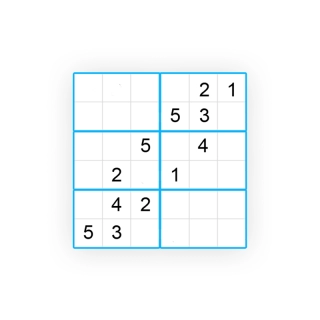
- Samurai Sudoku
This Sudoku variant has five overlapping Sudoku puzzles
- Super Sudoku 16×16
This is a more significant, monster-looking variation that has a 16×16 grid. Same game, same objective but bigger layout.
- Jigsaw Sudoku
Another variation with numerous inner blocks with random jigsaw shapes instead of squares.
- Word Sudoku
This variation of Sudoku has the same grid but uses words rather than letters to fill the cells without duplicating letters
- Some other variations include:
Magic Sudoku, Killer Sudoku, Kakuro, Pseudoku, and several others.
How to play Sudoku for beginners and expertsIt’s time to delve into the section you have been waiting for. And yes, the wait is entirely worth it after you have learned about the Sudoku rules and objectives, the different Sudoku variants, and many others.
Now that you are familiar with the Sudoku grid and the importance of filling in the rows, cells, and blocks without repetition. Get ready to learn the Sudoku instruction first as a beginner, then as an expert.
Some techniques required to solve puzzles are elementary, while some are advanced. Fret not. You do not need to learn the advanced techniques before you can solve a Sudoku puzzle.
Let’s delve in:
Levels of difficulty in the puzzleThe first thing you need to know is that the Sudoku puzzle is sometimes categorized according to their difficulty levels. Sometimes they could be termed “Easy,” “Medium,” “Hard,” “Evil,” or can even be rated between 1-5 stars.
Now here is the thing, a Sudoku rated “Easy” could become the most challenging puzzle you would encounter while the one termed “Hard” would be the easiest.
Hence, as a rule of thumb- never get swayed by the ratings on the puzzle. Instead, be sure of the techniques that work best for a puzzle.
Required tools for solving a Sudoku puzzleTwo types of tools are equally useful for solving and learning how to play Sudoku puzzle. These are:
- Physical tools: Pen, pencil, and paper
- Electronic tool: Using a computer
Using a physical tool to solve a puzzle is so adorable that you can work on any puzzle at your own pace. Cleaning and erasing until you come to a logical decision of what number goes in and where it goes to.
Don’t get it all wrong. Sudoku isn’t about guessing- it’s working on the puzzle until you reach a logical, final decision.
Several tools are available for lovers of computer software to help solve puzzles providing you with digital pencils to work on the puzzles. A typical example of such computer tools is Sudoklue.
Techniques for solving SudokuLet’s move into the techniques of how to play Sudoku. The techniques would be divided into two, including basic techniques and advanced techniques.
Basic TechniquesThese techniques are fun and interesting to grab. Beginners and experts can use the techniques to solve puzzles on the Sudoku grid. Though some of the techniques are hard to follow, they are worth learning because they always come through.
The techniques are:
- Open Singles
This appears to be the simplest and most straightforward way to fill in a Sudoku cell. The strategy thrives because there is only a row, column, or block that is missing one number. When it’s evident that only a number is left to be filled in, this technique comes in handy.
Check the below images for examples:
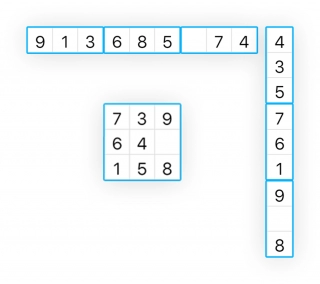
- A note on pencil marks
Here is an encompassing technique that requires you to put pencil to paper to track the number of possibilities and cells that are yet to be solved.
To do it:
- Spot an empty cell
- Trace out all the rows, columns, and blocks
- Insert all the possible numbers (from 1 to 9) that can be filled in the cells with a pencil
- Rinse, repeat
This allows you to carefully check out the possible candidates in a cell before making a final decision.
A simple hack: never fills in the cell by first doing all the 1s, 2s, 3s, and so. Instead, solve the puzzle cell by cell in a particular order and parse the numbers in a uniform order.
Check the image below for a pictorial example;
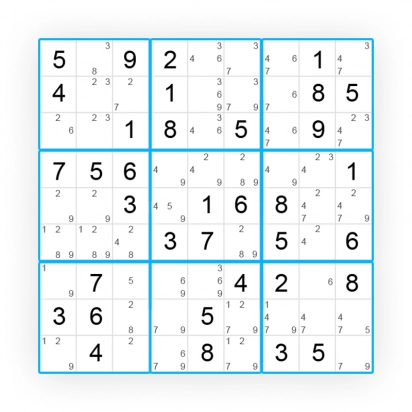
- Lone Singles
This technique comes in handy when there is only one pencil mark left in a cell. Once you have solved the puzzle to a stage where you only have a candidate left in a cell, then it’s time to apply “Lone Singles.”
Do this:
- Look across all the pencil marked cells from rows to columns to blocks.
- Erase any corresponding pencil marks
- Then, get your pen to fill in the final decision.
Check the below image for an example:
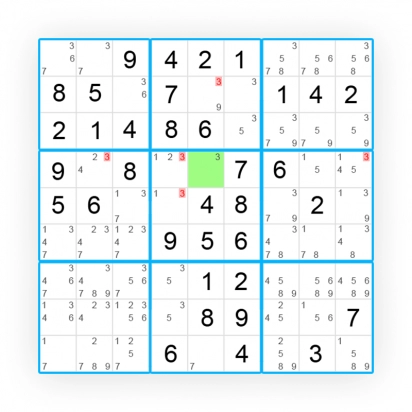
As you can see, the green “3” inside the box is the only “lone number” in the cell, which nullifies every other 3s across the column, row, and cell as possible answers.
- Hidden Pairs
These are almost the same as “Naked Pairs.” Where naked pairs occur when two exact pencil marks are available in the same rows, columns, and blocks, “Hidden Pairs” are buried naked pairs in the same rows, columns, and blocks, among other pencil marks.
See the image of two naked pairs of “2 3”:

See the image of two hidden pairs of “6 9,” among other pencil marks.
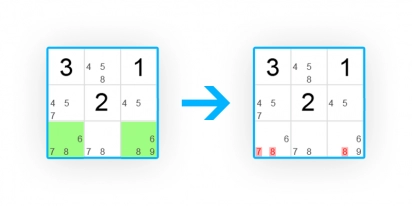
These basic techniques discussed are more than enough to solve any Sudoku puzzle. However, if you want to know more; here are some other techniques:
- Hidden singles
- Omission
- Naked Triplets & Quads
- Hidden Triplets and Quads
Truthfully, all the basic techniques discussed above are significant enough to solve more than 95% of all Sudoku puzzles you may ever come across either as a beginner or an expert. Therefore, only one sophisticated technique will be discussed here.
XY Wing TechniqueXY Wing is a rectangle-shaped grid that requires you to have 3 cells with two pencil marks that are somewhat related to base a logic conclusion.
Follow these to use XY Wing:
- Begin from the top-left corner of the puzzle down through a left-right position to form a “Y” shape (more or less like “V”)
- Pay attention to the cells with 2 pencil marks.
- Make a note of the 2 pencil marks and keep scanning until you have 3
- Then figure out the “middle” cell that intersects the “wing” cells.
- If you move downright, you will have two wing cells that share a pencil mark that doesn’t belong to the middle cell.
- Boom! There you have the pencil marks to remove.
Check the image below for a pictorial understanding:

More sophisticated techniques you can consider include:
- X-wing
- Swordfish
- Unique Rectangle
As an entertaining board game that requires no math, the Sudoku definition is simple. It is an engaging game that allows players to reason logically until they conclude the puzzle. There are several variations of Sudoku, but the most popular is the classic 9×9 grid, which requires number-placement without repetition across each cell board.
Becoming a master at the Sudoku grid is no rocket science. It only involves you to understand the basics, objectives, and rules of Sudoku. You can go over the different strategies discussed in the guide as many times as possible to ace the puzzle game.